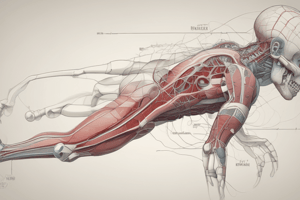Podcast
Questions and Answers
What is the primary function of the circulatory system?
What is the primary function of the circulatory system?
- to filter and remove waste products from the blood
- to protect the body against pathogens and diseases
- to produce and regulate hormones
- to bring oxygen into the body and remove carbon dioxide (correct)
What is the main function of the mitochondria in a cell?
What is the main function of the mitochondria in a cell?
- to generate energy for the cell through cellular respiration (correct)
- to regulate cell growth and division
- to synthesize proteins
- to break down and recycle cellular waste
What is the purpose of negative feedback loops in the body?
What is the purpose of negative feedback loops in the body?
- to transmit and process information
- to amplify changes in the body to maintain homeostasis
- to counteract changes in the body to maintain homeostasis (correct)
- to regulate body temperature
Flashcards are hidden until you start studying
Study Notes
Organization of the Body
- The human body is organized into several levels, from simplest to most complex:
- Chemical level: atoms and molecules
- Cellular level: cells, the basic structural and functional units of the body
- Tissue level: groups of similar cells that perform a specific function
- Organ level: structures composed of two or more types of tissues that work together to perform a specific function
- Organ system level: groups of organs that work together to perform a specific function
- Organismal level: the entire human body
Body Cavities
- The body has several cavities that contain and protect internal organs:
- Cranial cavity: contains the brain
- Thoracic cavity: contains the heart, lungs, and major blood vessels
- Abdominal cavity: contains the digestive organs
- Pelvic cavity: contains the reproductive organs
Body Systems
- The body has several systems that work together to maintain homeostasis:
- Nervous system: controls and coordinates body functions
- Circulatory system: transports oxygen and nutrients to cells and removes waste products
- Respiratory system: brings oxygen into the body and removes carbon dioxide
- Digestive system: breaks down and absorbs nutrients from food
- Endocrine system: produces and regulates hormones
- Immune system: protects the body against pathogens and diseases
- Integumentary system: protects the body from external damage and regulates body temperature
- Muscular system: moves the body and maintains posture
- Skeletal system: provides support and protection for the body
- Urinary system: filters and removes waste products from the blood
Cell Structure and Function
- Cell membrane: semi-permeable membrane that regulates what enters and leaves the cell
- Cytoplasm: gel-like substance inside the cell membrane where metabolic processes occur
- Nucleus: contains DNA and controls cell growth and division
- Mitochondria: generates energy for the cell through cellular respiration
- Endoplasmic reticulum: involved in protein synthesis and transport
- Lysosomes: contains digestive enzymes that break down and recycle cellular waste
Tissue Types
- Epithelial tissue: forms the lining of organs and glands, and protects the body from external damage
- Connective tissue: provides support and structure to the body, and connects organs and tissues
- Muscle tissue: contracts and relaxes to move the body and maintain posture
- Nervous tissue: transmits and processes information
Homeostasis
- Homeostasis: the ability of the body to maintain a stable internal environment despite changes in the external environment
- Negative feedback loops: mechanisms that counteract changes in the body to maintain homeostasis
- Positive feedback loops: mechanisms that amplify changes in the body to maintain homeostasis
Organization of the Body
- The human body is organized into six levels: chemical, cellular, tissue, organ, organ system, and organismal
- Each level builds upon the previous one, forming a complex system
Body Cavities
- The body has four main cavities: cranial, thoracic, abdominal, and pelvic
- Each cavity contains and protects specific internal organs
Body Systems
- There are nine major body systems: nervous, circulatory, respiratory, digestive, endocrine, immune, integumentary, muscular, and skeletal
- Each system performs a specific function and works together to maintain homeostasis
Cell Structure and Function
- The cell membrane is semi-permeable, regulating what enters and leaves the cell
- Cytoplasm is the gel-like substance inside the cell membrane where metabolic processes occur
- The nucleus contains DNA and controls cell growth and division
- Mitochondria generates energy for the cell through cellular respiration
- Endoplasmic reticulum is involved in protein synthesis and transport
- Lysosomes contain digestive enzymes that break down and recycle cellular waste
Tissue Types
- There are four main tissue types: epithelial, connective, muscle, and nervous
- Epithelial tissue forms the lining of organs and glands, and protects the body from external damage
- Connective tissue provides support and structure to the body, and connects organs and tissues
- Muscle tissue contracts and relaxes to move the body and maintain posture
- Nervous tissue transmits and processes information
Homeostasis
- Homeostasis is the ability of the body to maintain a stable internal environment despite changes in the external environment
- Negative feedback loops counteract changes in the body to maintain homeostasis
- Positive feedback loops amplify changes in the body to maintain homeostasis
Studying That Suits You
Use AI to generate personalized quizzes and flashcards to suit your learning preferences.




